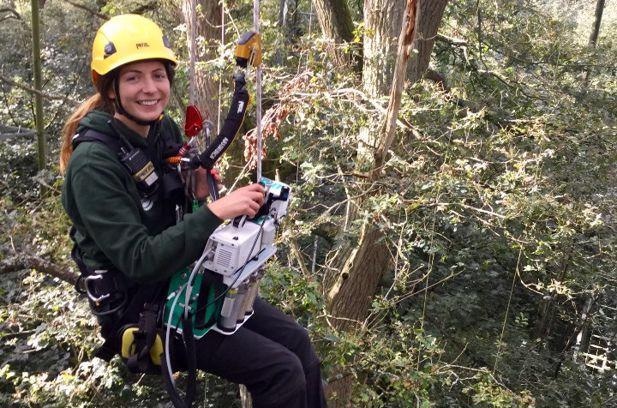A new study reveals that mature oak trees will increase their rate of photosynthesis by up to one-third as a response to the increase in CO2 levels anticipated to be the world average by around 2050.
 Anna Gardner carrying out fieldwork in the forest canopy. Image Credit: University of Birmingham.
Anna Gardner carrying out fieldwork in the forest canopy. Image Credit: University of Birmingham.
The study findings reported in the journal Tree Physiology are the first to come out of a huge outdoor experiment. The experiment was headed by the University of Birmingham and involved bathing an old oak forest in increased levels of CO2. In the first three years of a 10-year project, the 175-year-old oaks responded to the CO2 by constantly increasing their rate of photosynthesis.
Currently, wood, leaves, roots and soil are being quantified by scientists to determine where the additional carbon captured goes and for how long it remains closed in the forest.
The rise in photosynthesis was considered to be the greatest in strong sunlight. The total balance of key nutrient elements present in nitrogen and carbon did not alter in the leaves. Maintaining the carbon to nitrogen ratio indicates that the old trees have discovered methods of redirecting their elements, or found ways of fetching more nitrogen from the soil to balance the carbon they are obtaining from the atmosphere.
The study was performed at the Free-Air CO2 (FACE) facility of the Birmingham Institute of Forest Research (BIFoR) in close association with collaborators from Western Sydney University who run a quite similar experiment in old eucalyptus forest (EucFACE). BIFoR FACE and EucFACE are considered to be the world’s two largest experiments examining the effect of global change on nature.
I’m really excited to contribute the first published science results to BIFoR FACE, an experiment of global importance. It was hard work conducting measurements at the top of a 25 m oak day after day, but it was the only way to be sure how much extra the trees were photosynthesizing.
Anna Gardner, Researcher, University of Birmingham
According to Professor David Ellsworth, EucFACE lead scientist, “Previous work at EucFACE measured photosynthesis increased by up to a fifth in increased carbon dioxide. So, we now know how old forest responds in the warm-temperate climate that we have here in Sydney, and the mild temperate climate of the northern middle latitudes where Birmingham sits. At EucFACE we found no additional growth in higher CO2, and it remains to be seen if that will be the case for BIFOR as well.”
It’s a delight to see the first piece of the carbon jigsaw for BIFoR FACE fall into place. We are sure now that the old trees are responding to future carbon dioxide levels. How the entire forest ecosystem responds is a much bigger question requiring many more detailed investigations. We are now pushing ahead with those investigations.
Rob MacKenzie, Professor, Founding Director, Birmingham Institute of Forest Research
Journal Reference:
Gardner, A., et al. (2021) Is photosynthetic enhancement sustained through three years of elevated CO2 exposure in 175-year-old Quercus robur? Tree Physiology. doi.org/10.1093/treephys/tpab090.
Source: https://www.birmingham.ac.uk/index.aspx